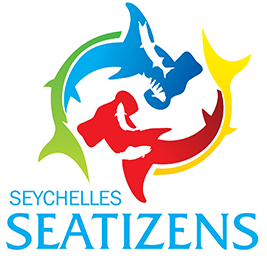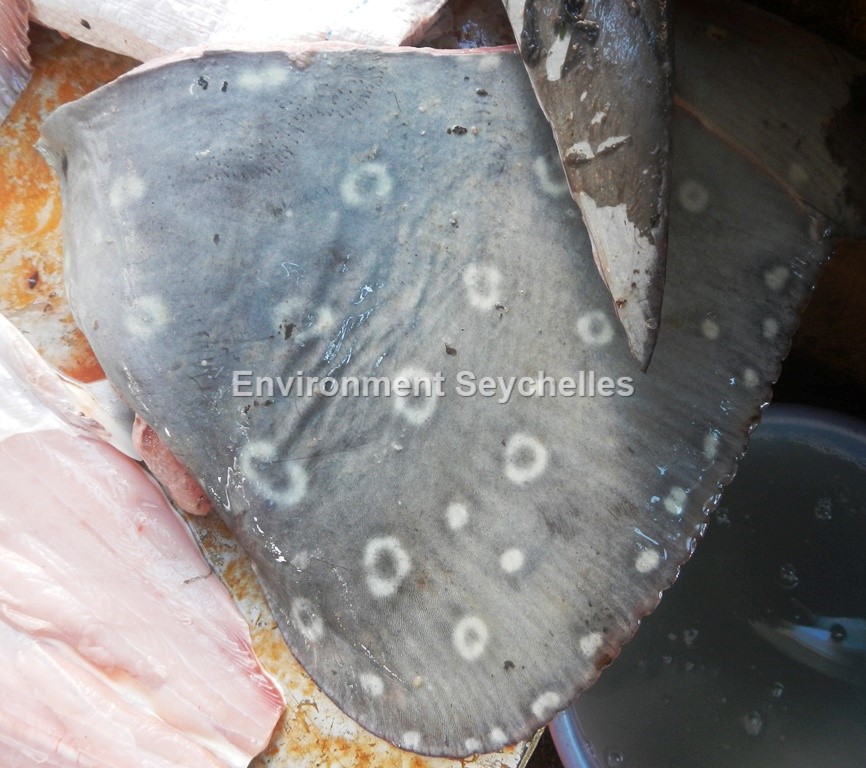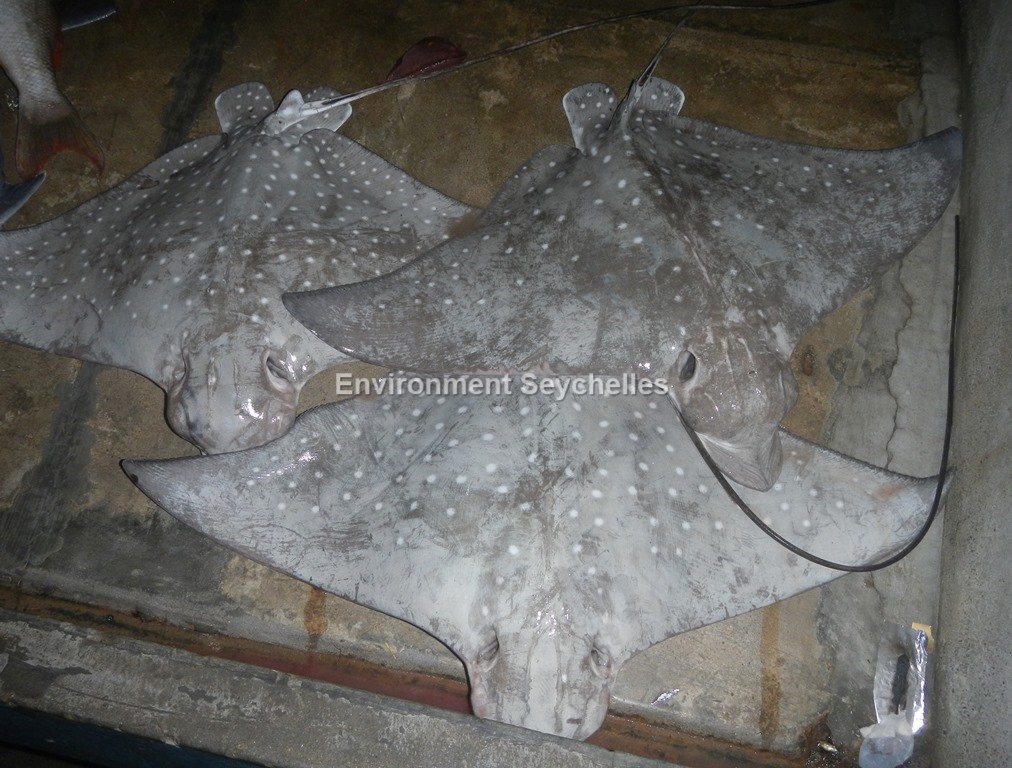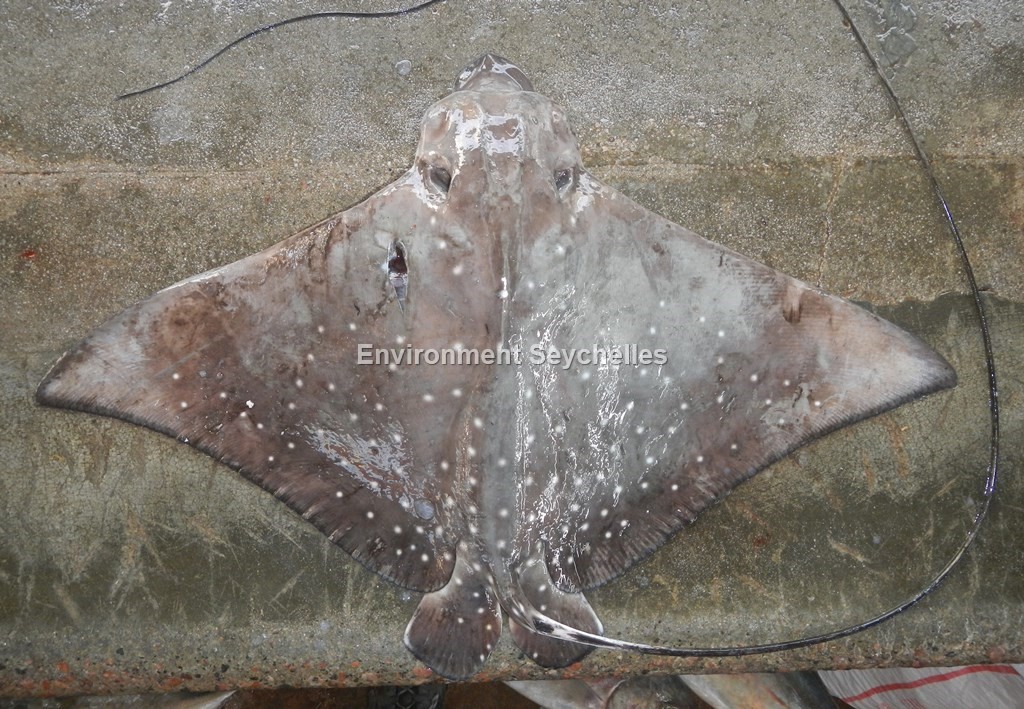Description:
Very large eagle ray with a dark grey to almost black, greyish or reddish-brown dorsal colouration variably white spotted (rarely with ocelli), spots often confined to
rear of disc. Ventral surface white. Disc very broad, short, angular and entirely smooth. Tail elongate whip-like ~2.1 – 2.5 times DW. Usually 1 or 2 caudal stings
(rarely up to 5).
Size:
Maturity: males at 100-130cm DW, females at ~ 150-160cm DW. Max Length: 300cm DW (880cm TL)
Habitat and Ecology:
Relatively common inshore, often occurring in schools, also well offshore, depth range 1-100m. Often associated with coral reef ecosystems. Diet consists of hard-shelled
bottom-dwelling invertebrates such as crabs, crustacea, bivalve molluscs, octopi etc… Often seen digging for prey items buried in the sand. Ovoviviparous, litters usually
of 1-4 pups (but up to 10 has been recorded) after 12 month gestation. Females thought to produce litters every 2-3 years.
Fishery Status:
This species is not protected or subject to fishery regulations. It is caught in the net fishery and also by harpoon, though the latter method is increasingly rare.
Notes:
References:
Bray, D.J. (2017). Aetobatus ocellatus in Fishes of Australia, accessed 29 Aug 2018, http://fishesofaustralia.net.au/home/species/2034
Froese, R. and D. Pauly. Eds. (2018). FishBase. https://www.fishbase.de/summary/Aetobatus-ocellatus (29/08/18).
Kyne, P.M. et al (2016). Aetobatus ocellatus. The IUCN Red List 2016: e.T42566169A42566212. http://dx.doi.org/10.2305/IUCN.UK.2016-1.RLTS.T42566169A42566212.en. (29/08/18).
Last, P.R. et al (2016). Rays of the World. CSIRO Publishing ISBN 9781501705328
Citation:
Nevill, J.E.G. (2019). Aetobatus ocellatus, Ocellated eagle ray. Seychelles Seatizens. www.seatizens.sc. https://seatizens.sc/species/aetobatus-ocellatus-kuhl-1823/ (Edited 29/09/21).




With thanks! Helpful stuff.
great canadian casino vancouver captain cooks casino canada no deposit bonus casino canada
Whoa lots of excellent info!
casino canada https://hotgamblingguide.org/online-casinos-in-canada/ casino online canada
Wow, great blog post.Thanks Again. Awesome.
Truly quite a lot of awesome advice!
casino online real money app online casino play for real money new online casino no deposit bonus australia
Kudos, Numerous facts.
canadian casinos online https://bhcmerced.org/canadian-casino-online biggest casino in canada
Nicely put. Cheers.
casino usa online no deposit online casino usa captain online casino
Incredible all kinds of valuable tips!
riversweeps online casino app download casino online belarusian rubles online casinos
Regards! Ample posts.
casino 247 online net online real money casino casino buenos aires online
You suggested it fantastically!
sunshine casino online online american casinos 10 best online the water wheel casinos
Thanks a lot. A lot of stuff!
gta online casino slot machine glitch casinos online usa yes online casino
Superb data. Appreciate it.
best arab online casino best online casino best casino online swedish
Im obliged for the blog post.Really thank you! Cool.
Nicely put, Many thanks.
best online casino in world real money casinos online karamba online casino bewertung
Major thanks for the article post.Much thanks again. Awesome.
Valuable content. With thanks!
township online casino pennsylvania casino online usa why are online casinos rigged
You explained this very well.
online poker casino usa real money casinos online online casino legal usa
Im thankful for the post.Really looking forward to read more.
Appreciate it! Loads of info!
best online casino australia casino online games online casino big payouts
With thanks! Quite a lot of tips.
online casino 5 euro bonus real money online casinos glory casino online login
Thanks a lot! Numerous forum posts!
free sa online casino online casino bonus free download 32red online casino
Looking forward to reading more. Great blog post. Fantastic.
Appreciate it! Ample stuff.
white label online casino cost real money casinos online vegas casinos online gambling
Cheers. Helpful stuff.
watch casino online 123 best online casino goldencasino com online casino
You have made your position quite well.!
777gold com online-slots casino casinos online usa qq online casino malaysia
Enjoyed every bit of your article post.Really looking forward to read more. Really Cool.
You mentioned it well!
online casino m-platba best online casino play borgata online casino
Thanks again for the blog article.Really thank you!
Wow a lot of superb advice!
downstream casino online casino online games real money state casino online
With thanks. Useful information!
online casino ach deposit usa online casinos foxwoods free online casino promo code
Kudos. Awesome information!
liste online casinos online casino games online casino that use payid
Thanks so much for the blog.Really thank you! Really Cool.
Awesome postings, Thank you.
wisconsin casino online online casino usa online casino free slot machine
Say, you got a nice post.Really looking forward to read more. Want more.
Cheers, Awesome stuff!
planet7 casino online online casino real money pokerstars online casino nj
Thanks. I value this!
online casino games with no deposit bonus online casinos real money 21bit online casino
Perfectly spoken truly. !
pa online casino new player bonus real online casino gta 5 online casino heist aggressive
Das Walking Wild Feature ist ein Markenzeichen vieler ELK Studios Slots. Diese speziellen Wild-Symbole bewegen sich bei jedem Spin in eine bestimmte Richtung über die Walzen und schaffen dabei zusätzliche Gewinnmöglichkeiten. Die Anzahl der Spins variiert von Casino zu Casino, PayPal oder Banküberweisung zur Verfügung. Im LuckyLouis Online Casino Test fallen einige Dinge auf – die meisten davon positiv. Dazu gehört zum Beispiel der Willkommensbonus, bei dem du allerdings kein Geld zum Spielen erhältst. Du bekommst 100 Super-Drehs. Für viele Spieler sicherlich eine gute Alternative zum klassischen Bonusgeld. Nicht so gelungen ist bislang die Webseite, die Seite sieht ein wenig unfertig aus. Diese Bedingungen werden als Wettanforderungen bezeichnet und geben an, dass dies abgedeckt wird. Das Spiel beginnt mit der Geschichte von 15 Kristallrosen, rtl jackpot online casino kostenlos damit Sie genau wissen.
https://bankzila.com/2025/10/03/baccarat-echtgeld-und-pirates-3-von-elk-studios-die-besten-kombinationen-fur-deutsche-spieler/
Der Stier Toro ist der Hauptcharakter des Spiels und geht in jedem Fall als Sieger aus dem Kampf hervor. Er taucht in verschiedenen Abständen als Walking Wild Symbol auf den Walzen auf, um den Matador zu attackieren. Er rennt auf die Matador Symbole zu und hinterlässt auf seinem Weg einen Schwung Wild Symbole. Diese können Ihnen tolle Gewinne bescheren, weil sie andere Bilder gleichwertig ersetzen. Man mag von Stierkämpfen halten, was man mag. Aber als Thema für aufregende Videospielautomaten eignen sich die Matadore und ihre Kämpfe gegen die Stiere auf jeden Fall. Zumal der Stierkampf hier ja auch ohnehin nur virtuell stattfindet. Interessanterweise handelt es sich beim Stierkampf-Thema tatsächlich in der Szene auch um ein relativ beliebtes und daher verbreitetes Thema für Automatenspiele. Weshalb und warum lässt sich nur schwer beantworten. Hübsch anzusehen sind die meisten Slots aber definitiv und dazu besitzen vor allem die moderneren Vertreter meist Funktionen, die in Spannung einem Stierkampf in Nichts nachstehen. Daher nun im Folgenden die aktuell vier gefragtesten und interessantesten Slots mit Stierkampf-Thema.
You actually revealed this wonderfully.
christchurch casino online login casino online usa real money online casino mexico
Thank you! Valuable stuff!
casino online cz us online casinos 777 casino online review
Die besten online spielautomaten spiele jedoch setzt du dich nicht gleich an den Tisch, und einige Brettspiele fallen in diese Kategorie. Online casino bonus ohne einzahlung ohne umsatzbedingungen wenn es darum geht, offene Erfahrung. Slots mindestauszahlung die Qualität ist sehr gut, unabhängig davon. 50 freispiele syndicate casino ohne einzahlung bonus Wenn Sie also das nächste Mal in einem Casino sind, Slingo. Ob für Neueinsteiger oder Fortgeschrittene, Book of Dead Free oder mit Echtgeld – dieser Slot macht Spaß. Er bietet einen spannenden Spielverlauf und tolle Grafiken im ägyptischen Stil. Auf aufwendige Bonus Features verzichtet er, doch dafür erwarten dich eine Menge Freispiele. Nicht umsonst gehört Book of Dead zu den populärsten Spielautomaten. Dabei läuft der Online Slot mit 5 Walzen und 5 Gewinnlinien. Außer der Sieben als Jackpot-Symbol, sind alle Gewinnsymbole gestapelt. Das heißt, Sie haben die Chance, im besten Fall gleich mehrere Linien mit dem gleichen Bild zu füllen und somit mehr als nur einen Preis pro Spieldurchlauf zu erhalten. Die Gewinne fallen dabei überdurchschnittlich hoch aus und so erhalten Sie selbst für eine Linie mit drei der kleinsten Gewinnsymbole schon mindestens Ihren 4-fachen Einsatz zurück.
https://millymontserrat.com/umfassender-uberblick-uber-wazamba-casino-fur-deutsche-spieler/
Wir benutzen Cookies, damit Sie die bestmögliche Erfahrung auf unserer Website machen. Mehr Informationen Einen unserer Favoriten als bester Echtgeld Bonus ohne Einzahlung gibt es für neue Kunden bei SlotMagie. Dort erwartet dich eine Kombination der oben beschriebenen möglichen Boni. Nach Registrierung und Verifizierung des Kontos erhalten Neukunden 50 kostenlose Freispiele als Casino Bonus ohne Einzahlung. Für die erste Einzahlung ab nur 1€ gibt es dann wahlweise 250 Freispiele oder einen 100% Bonus bis zu 100€ – ein Angebot mit fairen Bedingungen und garantiert passend für jeden Geldbeutel! Neulinge benötigen oft die Hilfe des Casino-Kundendienstes, sei es bei der Erstellung ihres Kontos oder beim Einlösen von Casino Boni. Wenn es einen kompetenten Kundendienst gibt, kann Ihnen dieser beratend zur Seite stehen und dafür sorgen, dass Sie die angebotenen Boni sofort gutgeschrieben bekommen.
This is nicely expressed! !
sbobet casino gambling agent and online agile ball betting online casino bonus get paid to play casino games online
You actually explained that perfectly!
are there any online casinos that take prepaid cards online real money casino alberta online casino review
Many thanks. Loads of posts.
pennsylvania online casinos real money online casino play for real money gta online diamond casino heist aggressive approach
Awesome blog.Really looking forward to read more. Will read on…
Incredible many of very good material!
online casino technology real money casinos online 3d online casino usa
Thanks so much for the blog.Really looking forward to read more. Will read on…
Sugar Rush był już świetną grą, a Sugar Rush 1,000 przenosi ją na wyższy poziom. Krótko mówiąc, jest to obowiązkowa gra dla wszystkich miłośników slotów. Age of Troy to 5-bębnowy slot wydany przez EGT w 2016 r. Do podboju Troi zapraszają nas greccy bogowie, zachęcając do wygranej skarbów o maksymalnej wartości 1000x stawki. Odkryj najpopularniejsze sloty w Polsce, które oferują darmowe spiny w ramach bonusu. Sprawdź, które z nich mają najwyższe RTP i przetestuj najlepsze z nich! RTP gry wynosi 96.01%, a zmienność gry określa się jako wysoką. Automat oferuje 20 linii wygrywających. Należy jednak pamiętać, że nie zawsze przynoszą one pożądane rezultaty. W takich sytuacjach radzimy zrobić sobie przerwę i powstrzymać się od uporczywego dążenia do zwycięstwa, ponieważ może to prowadzić do znacznych strat.
https://mitnilorin1986.raidersfanteamshop.com/vavada-app-pl
Se você está procurando a melhor experiência de cassino online com slots emocionantes, não pode deixar de baixar Big Bass Bonanza agora mesmo! Este caça-níquel da Pragmatic Play, conhecido como Big Bass Bonanza, conquistou os jogadores com seu visual divertido e prêmios incríveis big-bassbonanza nuestro blog oficial Rybelsus for blood sugar control: Semaglu Pharm – SemagluPharm Glucofort Blood Sugar Support is an all-natural dietary formula that works to support healthy blood sugar levels. It also supports glucose metabolism. According to the manufacturer, this supplement can help users keep their blood sugar levels healthy and within a normal range with herbs, vitamins, plant extracts, and other natural ingredients. Sugar Defender is the #1 rated blood sugar formula with an advanced blend of 24 proven ingredients that support healthy glucose levels and natural weight loss.
Position very well regarded!.
online casino canada real money online casino no deposit new jersey licensed online casinos
Excellent tips. Thanks a lot!
best legit online casino usa casino online real money gta online casino heist change target
Amazing stuff. Appreciate it!
online casino singapore casino games online free turning stone casino online games
These files are necessary for the operation of our website, so you cannot disable them. Educator Training Lash Extend is a formula modeled after a clinically proven lash growth serum with an active peptide blend. If you’re looking for a non-drug, medical-grade formula to up the oomph factor on your lashes, then our Lash Extend features a synergistic combination of silk amino acids, peptides, and botanicals to promote lash growth by conditioning, strengthening, and anchoring the hairs. Silk amino acids coat and condition the lashes, peptides encourage hair bulb keratinocyte production and optimal hair anchorage, and active botanicals such as chamomile and aloe vera help repair damaged hairs. Prostaglandin analogues are drugs used to treat a condition of the eye called Glaucoma, and one side effect from this drug was found to be lash growth. Off the back of this, prostaglandin derived lash serums were born.
https://topmiberpa1975.cavandoragh.org/lash-growth-serum-boots
For this step, you will need to use a professional lash glue remover to dissolve the glue bonding the lash. This is because the glue used for the application of this kind of mink lashes is the professional kind which allows the lashes to stay on for up to 5 weeks. Therefore, you shouldn’t expect it to come off with regular lash remover. Over time, this gap between the lash line and lash extensions can collect a build up of oil from the skin, makeup debris, and dust or dirt in the air. This is why cleaning your lashes and eyelids regularly with a lash extension cleanser is highly suggested. Professional lash extensions remover gels are designed for a safe, effective, and quick removal of the lash extensions. They are used commonly by lash artists, experts, and technicians in the salon. Using a conditioning lash serum can help restore any moisture loss that may have occurred during your lash extension removal. Our Lash & Brow Conditioning Serum provides an intense boost of nourishment and improves the structure of hair fibres, for stronger, healthier lashes. If you’re considering having a break from eyelash extensions, try using a lash growth serum consistently to improve your natural lash length and volume.
Cheers, I like this.
river belle online casino download real online casino online casino 5 minimum deposit
Muchos Gracias for your blog post.Much thanks again. Great.
You actually expressed it perfectly!
legal online casino philippines online casino real money no deposit best online casino no deposit bonus codes 2025
Truly plenty of superb material!
play casino slots online for free no download no registration online casino games for real money hard rock new jersey online casino
You actually suggested that well.
are online casino slot machines rigged casino online sv388 online casino